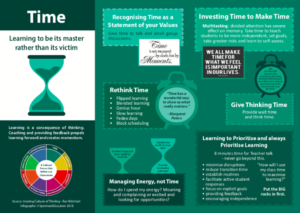Mastering Time in the Classroom
Learning to master time, rather than being its victim is one of the 8 cultural forces discussed by Project Zero, senior researcher Ron Ritchhart. He writes about 6 areas of time which can be harnessed and mastered to create a thinking culture in your classroom.
1 Recognise time as a statement of your values
What you give time to in the classroom (and life) is a reflection of what you value. If someone was to shadow you for a day in your classroom, what would they observe about your priorities and values? Would it be about building relationships, giving students a voice through discussion, ensuring instructions are understood, building thinking capacity, or merely getting the work completed.
Ron Ritchhart provides some reflective questions to ask yourself about your choices around time…
- Do I allow discussion to continue?
- Do I move on because I have 3 more points to make?
- Do I take time to review the material students are supposed to read?
- Do I allow students to experiment, raise questions and get confused, or do I just give them the information?
- Do I entertain the interesting question which is slightly off topic?
Whilst sometimes it feels, as a teacher, there is time pressure to ‘get through’ the curriculum, the important concept here is the messages you are sending students about what is and isn’t important in your classroom. It comes back to our values. If you believe a quiet class and getting through the curriculum are the most important priorities then you will spend more time and effort ensuring these happen.
2 Learning to Prioritise and always Prioritising Learning
If learning is the primary function of schools how are you demonstrating this? Ask your students what they think is important to you as the teacher in your classroom. This question can be very revealing!
Do you focus on what has been learned – or the completion of the work/task? A great question to ask yourself is – if you only had 6 weeks with your students, what would you want them to understand?
Stephen Covey popularised the ‘Big Rocks’ story – putting in the big rocks (the most important concepts/ideas/understandings) into the jar first, before adding the smaller pebbles and then the sand.The metaphor is about priorities as if your start with the sand and pebbles, there is no room for the rocks.
When you prioritise learning, there must be an understanding that learning is a consequence of thinking, and providing coaching and feedback is a key part of this. Students must also be challenged and stretched to ensure they are growing and learning.
Prioritising learning means keeping teacher talk to 8 mins or less (let’s face it, when you are talking students are not learning – learning happens in the reflection time) and reducing transition times. Conducting an audit on learning time is both revealing and a brave undertaking in most classrooms. I was recently involved in an audit of this type and there was 47 minutes a day used just in packing up time! In another, the teacher would personally hand out the writing books to each student, taking time away from the learning process. In what ways might you redesign, practice and streamline the transition times in your classroom?
3 Give Thinking Time
Mary Budd Rowe’s iconic wait time research shows that increasing the time between asking a question and a student answering it, leads to a dramatic improvement in learning and inference. Her research showed that the average teacher, after asking a question, waited one second before doing one of three things; calling upon a student to answer, answering the question themselves or asking a new question. This is not enough time for great thinking to occur. The recommended wait time is between 7 – 10 seconds. This feels like a lifetime to a teacher, however it is time for students to make decisions, evaluate and problem solve – to think. A colleague of mine says, “Wait until it hurts, and then wait some more!”
When giving instructions, students are often impulsive and only hear the first instruction. Thousands of teachers have had tremendous success with the phrase: “In a moment, but not quite yet…” This signals the brain to stop and wait and listen to all the instructions before moving or taking action. In addition you might also use this phrase after giving a set of instructions. “If you were following these instructions correctly, what would you do doing?” This allows a learner to take a moment and do some mental rehearsal of what they are about to do, thus being more likely to follow the directions precisely.
Another phrase I hear myself saying regularly when I am conducting model lessons in the classroom is, “What I am interested in is not that you are the first to answer, however you have taken the time to think about your answer.” Many times teachers have reinforced the notion of being first, by calling upon the first to raise their hand, or the person sitting up straight. I recommend no hands up and giving think time to learners and then you can call upon any student.
Below is a fabulous video sharing the frustration, anxiety and tension that arises within the learning environment when no think time is given.
4 Investing time to make time
Can you make more time? No, however we can invest time in streamlining routines and procedures so there is more time available for your learning priorities. Investing time to teach students how to transition between activities, pack up, settle into the next activity is critical. This initially takes time out of a few lessons however the long term benefits are huge.
I saw this done as an action research in a classroom. The teachers and students brainstormed the behaviour and structure of the desired outcome (eg: Transitioning to the next activity and starting it quickly.) Then they practiced the transition. As soon as someone deviated from the desired outcome, the teacher would stop everyone and a discussion about what happened would ensue. Problems were identified, feedback given, solutions discussed and then the practice would happen again. Over the course of the next week, with continued feedback and discussions, students progressively got better at the routine until it was performed with the desired outcome. Investing this time at the beginning will give you more time in the long term.
Investing time to make time also includes teaching students to be more independent in their learning. This means ensuring students are clear of their goals, and know what to do when they are stuck, or the answer is not immediately apparent. Empowering students to problem solve, without teacher input, to be able to take a responsible risk and give something a go, even when they are not sure, will free up the teacher time. Again this requires explicit teaching practice and feedback.
5 Rethinking time
Rethinking time can be challenging, especially in a school where a timetable and bells dictate the learning. In saying this, many schools, internationally, are testing out different ways to deliver content and maximise the learning in classrooms. Ideas include using approaches such as Flipped Learning, Blended Learning, Genius Hour or Passion Projects, Slow Learning and Block Scheduling. All of these practices are worth exploring with a clear focus on learning and educational outcomes for the students.
6 Managing energy – not time
Have you noticed the more stressed you are – the less time you feel you have? Of course time is a fixed commodity, however energy is not. Energy is a renewable resource. Lowering your stress levels by managing your energy levels might just help you feel more in control and ‘on top’ of the workload, therefore perhaps giving the illusion of more time.
Managing your energy levels comprises of some of the basics such as eating nutrient rich food and drinking water. Fitting in daily exercise does not have to take hours. Lauren Parsons promotes the ideas of snacking on exercise – 1 minute of huffy puffy, blood pumping activity 4 times a day – which can make a marked difference to your health and energy levels.
Another idea is to surround yourself with positive people. People who add to your energy levels rather than deplete them. Laughter, support, love and connection all fuel your energy.
Of course, it is important to take time to rest, relax and rejuvenate. To take opportunities for downtime, breathing deeply and to recharge. Day dreaming and periods of silence can also be revitalising. Dr Libby, a holistic nutrition specialist, cautions that many people are waking themselves up with coffee and cooling themselves down at night with alcohol, both of which are sapping energy. Kirsty Spraggon talks about ‘when you numb pain (discomfort, fear etc), you numb joy.’ Our emotions are not discerning. This message aligns with Dr Libby’s.

One practice that many people are finding energy giving is a daily gratitude habit. Journaling or sharing 3 things a day that you are grateful for, can simply change your perspective on life and lower stressed feelings. I started a Gratitude group online and it is gaining momentum every day. The feedback is overwhelmingly positive. Even on the hard, bad and painful days, there is always something that you can find gratitude for. You are welcome to join at https://www.facebook.com/groups/2130234256994390/
Ideas for implementation:
- Conduct a time audit in your classroom to find out how much time is spent in instructional time versus learning time
- Practice increasing your wait time
- Make a list of ways you spend time with your class – gather student perspectives
- Ask students what they think you value in your classroom
- Identify which transitions, routines and procedures you can spend time on now to increase learning time later
- Empower students to take responsible risks and solve their own problems, rather than always asking the teacher
- Identify the BIG rocks and ensure you give time to these
- Try out a ‘new’ (for you) way of teaching such as flipped learning or Genius Hour.
- Create energy renewal rituals

To download a complimentary copy of this infographic please click here
** This article is the third in a series of 8, focusing on the 8 Cultural Forces and Cultures of Thinking.
Want to know more?
Please go to www.spectrumeducation.com/cultures-of-thinking-webinar-series for a live webinar or contact us for information about the recorded videos from this series.
To purchase and download all 8 posters please go to www.spectrumeducation.com/cultures-of-thinking-infographics/
Tags: 8 Cultural Forces, Cultures of Thinking, Karen Tui Boyes, time
Published on Thursday, June 7th, 2018, under Cultures of Thinking, Learning, Teacher Effectiveness
